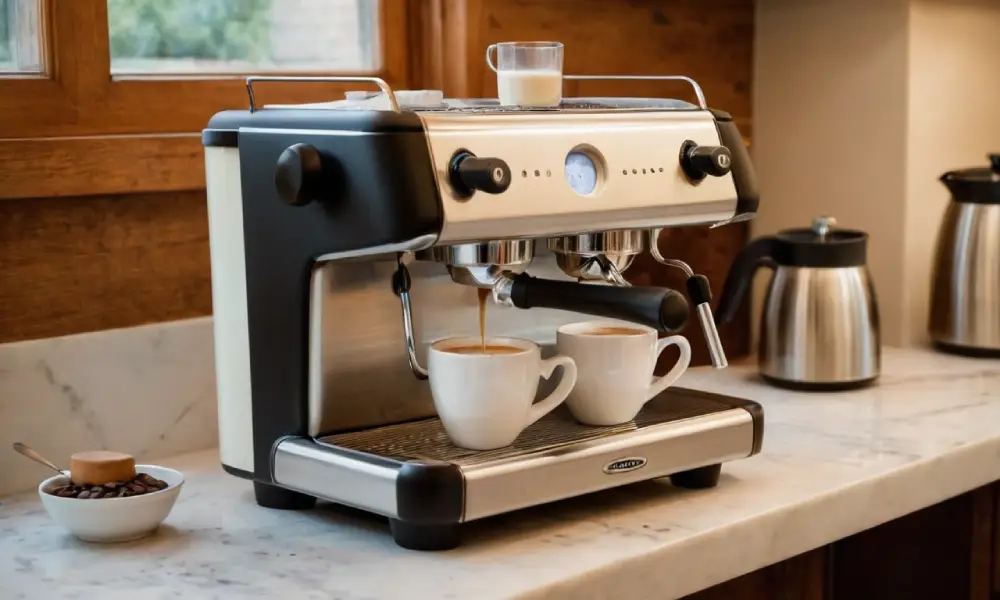Have you ever wondered what goes into making the perfect flat white?
At Regency Cafe, we’re all about that smooth, velvety texture and rich espresso, but we’re also here to have a little fun with it.
Whether you’re an espresso expert or just starting to dip your toes into the coffee world, learning how to master the flat white is easier than you think. Ready to find out how to brew it like a pro?
Let’s dive in

1. Choose Your Espresso Machine (Yes, It Makes a Difference)
Not all espresso machines are created equal, and that’s okay.
Whether you’re brewing with a high-end machine or a budget-friendly option, it all comes down to how much steam power you have. Here’s the lowdown:
High-End Machines (Sage Dual Boiler, La Marzocco): If you’ve got one of these bad boys, you’re in for a treat. With their powerful steam wands, you’ll be aerating your milk in about 15-20 seconds. This means you’ll get a beautiful microfoam, perfect for latte art. Speedy, silky, and professional-level results – it’s almost like having a barista in your kitchen (minus the tattoos and cool apron).
Mid-Range Machines (Gaggia Classic Pro): These machines aren’t as fast, but they still get the job done well. Expect to spend about 30-40 seconds on milk aeration. You’ll be in good shape, but it might not be as fast as your local coffee shop.
Budget Machines (DeLonghi Dedica, Thermoblock Machines): These machines take a little more patience. With thermoblocks, they heat water on demand, so don’t rush it! You’ll likely need 45 seconds or more to get the milk frothed properly. It may not be as quick, but hey, good things come to those who wait.
2. Steaming the Milk – The Art of Aeration
Now comes the fun part: steaming the milk.
The goal here is to create a smooth, velvety texture that’ll give your flat white its signature creaminess. Here’s how to nail it:
Start Aerating: Stick the steam wand into your milk and start aerating. You should hear a soft “ripping paper” sound – this means you’re adding air to the milk without overdoing it. If you hear a loud “roar” or bubbling, it’s a sign you’re going too hard on the aeration. Let’s keep it classy, not a wrestling match.
Stop When It’s Warm: For most machines, once the jug feels warm to the touch, you can stop aerating. If you’re using a high-end machine like the Sage Dual Boiler, you might stretch the milk a little longer, but aim for that smooth, velvety texture. Overdo it, and you’ll end up with foam that’s more suited for a cappuccino than a flat white.
Perfect Microfoam: After aerating, swirl the milk gently in the jug to break up any large bubbles. The milk should look shiny and silky, with no visible foam or large bubbles. If it’s too bubbly, just give it a quick tap on the counter and swirl again.
3. The Pour – Let Your Inner Artist Shine
Here’s where you get to show off (or just enjoy a great cup of coffee).
The key to a flat white is the balance between the milk and espresso, plus that smooth, creamy texture.
Cup Size: A typical flat white is served in a 5-8 ounce cup. Why? Because it’s all about the balance of milk to espresso. Too much milk, and it becomes more of a latte; too little, and you’ve got an espresso with a splash of milk. Stick to the 5-8 ounce rule, and you’ll be in flat white heaven.
Latte Art (Optional, But Fun): If you’re feeling fancy, now’s the time to try some latte art. Pour the milk slowly into the centre of your espresso, and as you pour, start to tilt the cup and make small, controlled movements. If you’ve got the right milk texture, you’ll be able to create that beautiful heart or rosette. And if it doesn’t work out the first time? No biggie. Just enjoy your coffee and try again next time. Rome wasn’t built in a day, and neither is perfect latte art.
4. What to Avoid – Mistakes We’ve All Made
We’ve all been there. You try to steam your milk, and it either turns into a frothy mess or doesn’t foam at all. Here’s what to keep an eye out for:
- Under-Aeration: If your milk is too thin or runny, you didn’t aerate enough. Try stretching it a bit longer next time, but don’t go crazy – we’re aiming for microfoam, not a foam party.
- Over-Aeration: If your milk has too much foam or feels too airy, you’ve gone a bit overboard. Stop aerating a bit earlier, and you should get that smooth, creamy texture we’re aiming for.
- Burnt Milk: If you overheat your milk (anything above 70°C or 158°F), you’ll get that burnt taste – not ideal. Keep the milk temperature between 60-65°C (140-149°F) for the best results. You can use a thermometer if you’re unsure, or just give the jug a quick feel. When it starts to get hot but not scalding, you’re golden.
5. No Espresso Machine? No Problem!
Don’t have an espresso machine? Don’t worry – you can still make a great flat white. Try a stovetop espresso maker or even a French press (yes, really).
- Using a French Press: Heat your milk and pour it into a French press. Then, pump the plunger up and down until it froths. Pour it over your espresso, and you’ve got yourself a flat white. It’s not as fast as the fancy machines, but it works!
Final Tips:
Consistency Is Key: The more you practice, the better you’ll get. Don’t get discouraged if your first few attempts aren’t perfect. Coffee is an art, and even the best baristas were once beginners.
Experiment: Don’t be afraid to adjust the milk-to-espresso ratio or tweak your aeration technique. Coffee is personal, and the more you play around, the closer you’ll get to your perfect flat white.




